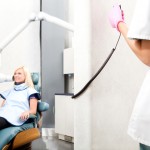
In recent years there has been a shift in intraoral dental imaging from conventional to digital film. While conventional film is still considered to provide superior spatial resolution the shorter working time, reduced processing errors and improved image storage of digital technologies have seen their use expand.
Currently two main options are direct digital sensors (DDSs) and indirect photostimulable phosphor plates (PSPs). The aim of this review was to identify the diagnostic capability of PSPs and DDSs in the detection of interproximal caries.
Methods
Searches were conducted in the Medline/PubMed, Embase, LILACS, Cochrane Library, the Web of Science and Google scholar databases. Studies that evaluated the diagnostic capability of PSPs and DDSs in detecting interproximal caries in human teeth, in both dentine and enamel that used histology as a reference standard were considered.
Two reviewers independently selected studies with disagreements being resolved by a third. Three reviewers independently assessed study quality using the QUADAS-2 checklist.
The primary outcomes were sensitivity and specificity with regard to detection of dental caries. Secondary outcomes were positive predictive value (PPV), negative predictive value (NPV), likelihood ratio (LR), and odds ratio (OR).
Results
- 6 studies were included with 4 contributing to the meta-analysis.
- Only 1 of the 6 studies reported a significant difference between PSP and DDS technologies.
- The methodology of the included studies was considered to be at low risk of bias.
- The meta-analysis evaluated 668 interproximal human tooth surfaces. All studies used extracted human teeth ranging from no caries present to caries into dentine
- Meta-analysis showed that intraoral digital imaging is of high specificity but low sensitivity in the detection of interproximal caries.
| Sensitivity (range) | Specificity (range) | |
| PSP | 15% to 54% | 84% to 100% |
| DDS | 16% to 56% | 90% to 100% |
Conclusions
The authors concluded: –
While DDS and PSP systems were excellent at identifying surfaces without caries (specificity), both lacked sufficient sensitivity to reliably identify surfaces with caries. No significant difference was noted between the performances of DDS and PSP digital systems. However, their low sensitivity dictates that the clinician must remain vigilant in corroborating all radiographic findings with a careful clinical evaluation for early interproximal lesions.
Comments
The authors have followed a sound methodological approach for this review with a wide ranging database search and the use of QUADAS-2 to assess the included study quality. They have also chosen the robust reference (gold) standard of histology. The use of this reference standard means that only a small number of studies could be included as they acknowledge. It also means that all of the studies we conducted on teeth ex-vivo.
The reviewers note that in the included studies conventional film demonstrated similar sensitivities and specificities to DSD and PSP. A recent review and meta-analysis of conventional film by Schwendicke et al (Dental Elf – 10th Jun 2015) which used a less robust reference standard found average sensitivities of 35% and 41% and specificities of 78% and 70% for clinical and in vitro studies retrospectively. While histology is a very good reference standard the authors also noted that there was no standardisation of the techniques used across the included studies.
Links
Primary paper
Winand C, Shetty A, Senior A, Ganatra S, De Luca Canto s, Alsufyani, Flores-Mir C, Pachêco-Pereira. Digital Imaging Capability for Caries Detection- A Meta-analysis. JDR Clinical & Translational Research July 2016 vol. 1 no. 2 112-121 Published online before print April 25, 2016, doi: 10.1177/2380084416645291
Other references
Dental Elf – 10th Jun 2015
Radiographic caries detection is highly accurate for cavitated proximal lesions
Dental Elf – 9th Jun 2015
Dental Elf – 15th Oct 2013
Little evidence for the diagnostic accuracy of new caries detection aids

Digital imaging for caries: direct digital sensors vs photostimulable phosphor plates https://t.co/B7OVrjhkfy
Digital imaging of caries with direct digital sensors & photostimulable phosphor plates had similar sense & spec https://t.co/B7OVrjhkfy
Direct digital sensors or photostimulable phosphor plates for digital imaging of caries https://t.co/B7OVrjhkfy
@TheDentalElf If these two systems’d reduce the probability of geometric unsharpness just as EPT false(+) or (-),it’d be useful to practice.
Little difference between direct digital sensors and photostimulable phosphor plates for caries imaging https://t.co/B7OVrjhkfy
Don’t miss- Digital imaging for caries: direct digital sensors or photostimulable phosphor plates? https://t.co/B7OVrjhkfy